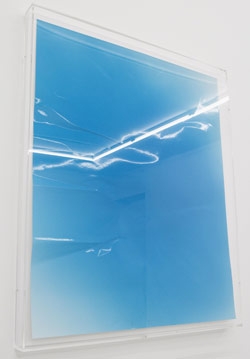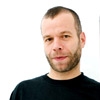Exhibiting the ‘now’
Text: Iida Shihoko
Portrait: Nagare Satoshi
On a wet spring night at the scene of his solo show, Wolfgang Tillmans stood surrounded by starstruck admirers. Flashing the same charming smile as his previous trip to Japan four years earlier, he patiently signed every autograph requested. Two rooms of Tillmans’ work are on display here, with that composed of four new ‘three-dimensional’ works seeming to form a single coherent whole.
“Often photography is considered bodyless – without body,” he says. “But I always considered it to be embodied images. While very flat, what you actually see is three-dimensional.”
 Lighter 47, 2008
Lighter 47, 2008Courtesy the artist and Wako Works of Art
Photo Nagare Satoshi
Tillmans’ Lighter series, first unveiled in 2006 in New York, consists of works that are truly solid, sculptural: vividly colored exposures on photographic printing paper with folds and bumps. Can such work really be discussed within the confines of photography? According to Tillmans:
“This series comes out of a broader consideration of what has always been understood as an object. Mine is not an evolutionary development. Work comes out as a new thing, now, something that has somehow been in the making. Photography recalls things in our heads, but in fact a good work of art should also be present in the ‘now’. In a way this is a sign of a good work: if it always exhibits new time.”
No need to be always new, but needing always to be now: in other words, contemporaneous. In addition to Lighter, the other room of the exhibition, packed with works including photocopies of his own creation stretched enormously, and photos of religious buildings, is a space rendered so diverse, so radical, and so conceptual as to be provocative. What prompted the change?
“I somehow felt I needed to address certain things to the world that I couldn’t necessarily address entirely in my own photographs, and I wanted to represent what I was thinking about and actually doing a lot of the day, and how can I comment on the world. Another change is my engagement with religion, I guess with the whole 9.11 thing.”
People will no doubt look at this array of works and read things into them, interpret them, misinterpret them. Which is largely out of the artist’s control.
“I always try to cover a lot of ground; somehow I feel this urge to bring out the complexity of the different things I am thinking about. I want to continue speaking freely with my materials, whatever they might be. Also I want to stay on message. I don’t want to disappear into too specialized an art-specific world. I’m interested in how to connect human life and society, and that does not mean moving into abstraction and away from people.”
Tillmans has said that photography is the most economical way to absorb the world, and that he takes photos in order to connect with the world. While evolving in an astoundingly circular fashion, he remains yet on the same plane as the rest of us, in the same era: a tremendous source of courage for us.
Originally printed in ART iT 20 Summer/Fall 2008

Wolfgang Tillmans
Born 1968 in Remscheid, Germany; lives and works in London. Since being awarded the Turner Prize in 2000, has had large-scale exhibitions at major museums around the world, including Freischwimmer at Tokyo Opera City Art Gallery in 2004. His first Japanese exhibition in four years, Lichter, took place at Wako Works of Art (Tokyo) in Spring 2008, at the same time he was showing in History in the Making: A Retrospective of the Turner Prize at the Mori Art Museum (Tokyo).
